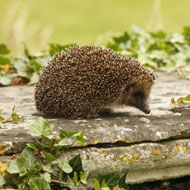
A petition calling for ‘hedgehog highways’ to be added to all new-build housing developments has been signed by more than 300,000 people.
Ecologist and author Hugh Warwick started the petition on Change.org, urging the housing and planning minister, Kit Malthouse, to take steps to protect hedgehogs.
In the past 18 years, urban hedgehog numbers have dropped 18 per cent, while rural hedgehogs fell by 50 per cent, according to the State of Britain’s Hedgehogs report. Housing developments are a key threat, as they fragment the land into smaller pieces, stopping hedgehogs moving freely between gardens to find food.
Mr Warwick, of the British Hedgehog Preservation Society, is calling for all new fences on housing developments to have a 13cm square cut into them to allow hedgehogs to move from garden to garden. Wildlife-sensitive planting, ponds and bat and swift bricks also help to ensure housing estates offer homes for wildlife.
“We know that hedgehog numbers are declining,” Mr Warwick said. “And we know that one of the biggest problems they face is the way we chop our land up into smaller pieces. This often happens when new fences are put in place - and as we are facing a house building boom there are going to be hundreds of thousands of new barriers to hedgehog movement.”
Fay Vass, chief executive of BHPS, added: “This petition is aimed at making new build sites better for hedgehogs, but improvements can also easily be made in existing homes too!
"Hedgehog Street is a project we run with People’s Trust for Endangered Species and its website offers a wealth of information and advice for homeowners wanting to help our prickly friends, you can even sign up to be a Hedgehog Champion!”



 BSAVA is to partner with BVA Live (11-12 June 2026) to champion clinical research.
BSAVA is to partner with BVA Live (11-12 June 2026) to champion clinical research.